托福口语题型分析与要点
- 格式:pdf
- 大小:173.88 KB
- 文档页数:11
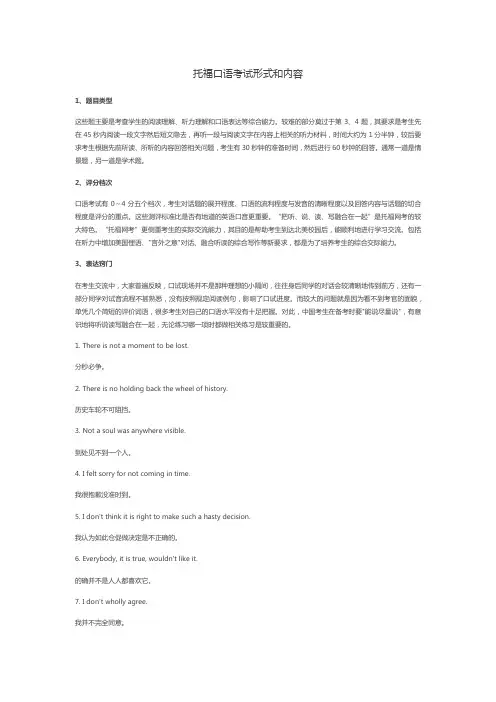
托福口语考试形式和内容1、题目类型这些题主要是考查学生的阅读理解、听力理解和口语表达等综合能力。
较难的部分莫过于第3、4题,其要求是考生先在45秒内阅读一段文字然后短文隐去,再听一段与阅读文字在内容上相关的听力材料,时间大约为1分半钟,较后要求考生根据先前所读、所听的内容回答相关问题,考生有30秒钟的准备时间,然后进行60秒钟的回答。
通常一道是情景题,另一道是学术题。
2、评分档次口语考试有0~4分五个档次,考生对话题的展开程度、口语的流利程度与发音的清晰程度以及回答内容与话题的切合程度是评分的重点。
这些测评标准比是否有地道的英语口音更重要。
“把听、说、读、写融合在一起”是托福网考的较大特色。
“托福网考”更侧重考生的实际交流能力,其目的是帮助考生到达北美校园后,能顺利地进行学习交流。
包括在听力中增加美国俚语、"言外之意"对话、融合听读的综合写作等新要求,都是为了培养考生的综合交际能力。
3、表达窍门在考生交流中,大家普遍反映,口试现场并不是那种理想的小隔间,往往身后同学的对话会较清晰地传到前方,还有一部分同学对试音流程不甚熟悉,没有按照规定阅读例句,影响了口试进度。
而较大的问题就是因为看不到考官的面貌,单凭几个简短的评价词语,很多考生对自己的口语水平没有十足把握。
对此,中国考生在备考时要"能说尽量说",有意识地将听说读写融合在一起,无论练习哪一项时都做相关练习是较重要的。
1. There is not a moment to be lost.分秒必争。
2. There is no holding back the wheel of history.历史车轮不可阻挡。
3. Not a soul was anywhere visible.到处见不到一个人。
4. I felt sorry for not coming in time.我很抱歉没准时到。
5. I don't think it is right to make such a hasty decision.我认为如此仓促做决定是不正确的。
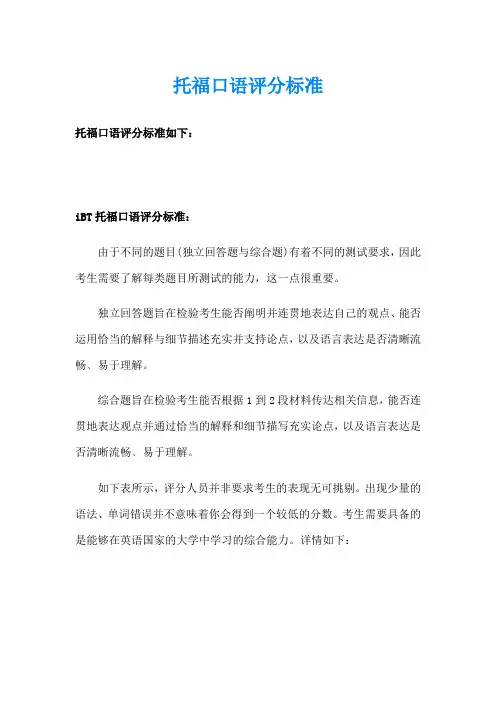
托福口语评分标准托福口语评分标准如下:iBT托福口语评分标准:由于不同的题目(独立回答题与综合题)有着不同的测试要求,因此考生需要了解每类题目所测试的能力,这一点很重要。
独立回答题旨在检验考生能否阐明并连贯地表达自己的观点、能否运用恰当的解释与细节描述充实并支持论点,以及语言表达是否清晰流畅﹑易于理解。
综合题旨在检验考生能否根据1到2段材料传达相关信息,能否连贯地表达观点并通过恰当的解释和细节描写充实论点,以及语言表达是否清晰流畅﹑易于理解。
如下表所示,评分人员并非要求考生的表现无可挑剔。
出现少量的语法、单词错误并不意味着你会得到一个较低的分数。
考生需要具备的是能够在英语国家的大学中学习的综合能力。
详情如下:六大Tasks题型分析Independent Topics题型Independent task 1是Free Choice题,要求考生就某一常规话题用英语做45秒钟的陈述。
考生对于这道题的准备应主要集中在people、place、object、event (人、地、物、事)这几个大方面。
建议考生扎实准备OG、Longman 综合教程以及口语特训等教材上的题目,虽然在考试时直接考到它们的几率并不大,但是在复习过程中准备过的具体内容在考场上的作用却非常大。
比如“Describe the place you live in”与“Which city do you travel to most”、“Who is the person you admire most”与“Whom would you choose to visit for one hour”就可以相互借用大部分内容。
Independent task 2是Paired Choice题,也就是要求考生在提供的两个选择中选择自己喜欢的一个,并用details和examples支持自己的观点。
如“ If you could choose to live in the city or live in the country areas, which lifestyle would you prefer and why”,考生需要做的是迅速确定自己的立场,其余的按照 Free Choice的准备就可以了,同时比Free Choice更好的表述是考生可以采用“抨击”另一种观点的方式来准备details,如考生可以陈述live in the city的不好来表达自己的观点——I prefer to live in the country。
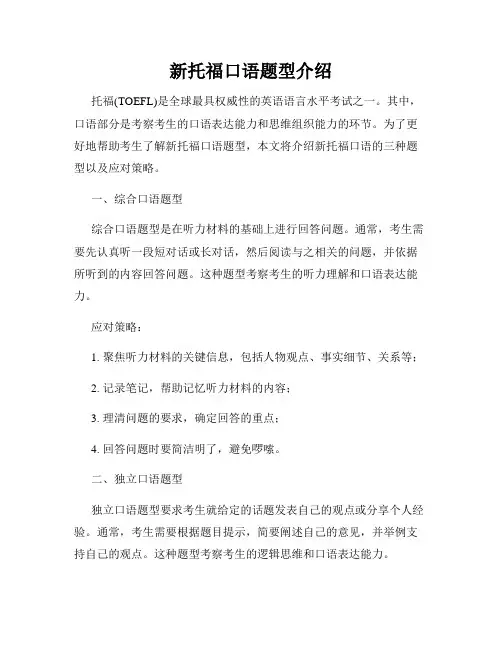
新托福口语题型介绍托福(TOEFL)是全球最具权威性的英语语言水平考试之一。
其中,口语部分是考察考生的口语表达能力和思维组织能力的环节。
为了更好地帮助考生了解新托福口语题型,本文将介绍新托福口语的三种题型以及应对策略。
一、综合口语题型综合口语题型是在听力材料的基础上进行回答问题。
通常,考生需要先认真听一段短对话或长对话,然后阅读与之相关的问题,并依据所听到的内容回答问题。
这种题型考察考生的听力理解和口语表达能力。
应对策略:1. 聚焦听力材料的关键信息,包括人物观点、事实细节、关系等;2. 记录笔记,帮助记忆听力材料的内容;3. 理清问题的要求,确定回答的重点;4. 回答问题时要简洁明了,避免啰嗦。
二、独立口语题型独立口语题型要求考生就给定的话题发表自己的观点或分享个人经验。
通常,考生需要根据题目提示,简要阐述自己的意见,并举例支持自己的观点。
这种题型考察考生的逻辑思维和口语表达能力。
应对策略:1. 明确自己的观点,可以选择赞同或反对事物,并列出理由;2. 举例论证,可以通过个人经历或社会案例支持观点;3. 使用合适的语言表达,例如使用连词、过渡词等使思路更为清晰;4. 合理控制回答的时间,不要超时或不足。
三、口语综合提示题型口语综合提示题型结合了综合口语和独立口语的特点,要求考生在听力材料和问题提示的基础上回答问题。
通常,考生需要先听一段短对话或长对话,然后阅读问题提示,根据所听到的内容回答问题。
这种题型考察考生的听力理解、逻辑思维和口语表达能力。
应对策略:1. 听力材料结束后,尽快阅读问题提示,明确问题要求;2. 回顾听力材料,重点关注与问题相关的信息;3. 使用合适的语言表达,清晰陈述观点和理由;4. 注意回答问题时的条理性,可以使用段落链接词使回答更有逻辑性。
结语通过本文对新托福口语题型的介绍,相信考生们可以更好地应对考试中的口语部分。
在备考过程中,请考生充分利用限时模拟练习,提高自己的听力理解和口语表达能力。
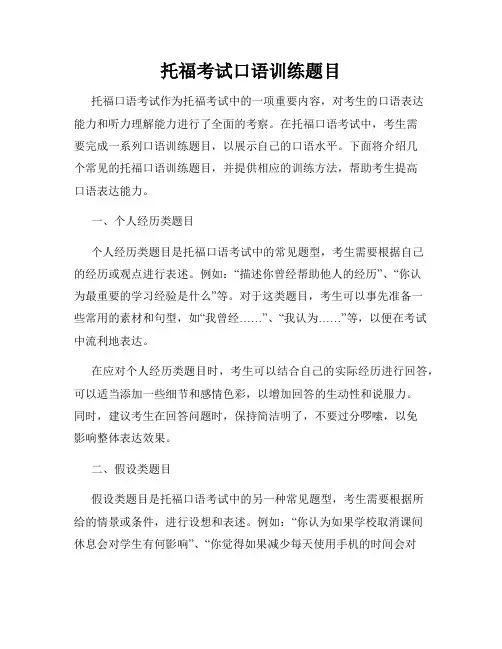
托福考试口语训练题目托福口语考试作为托福考试中的一项重要内容,对考生的口语表达能力和听力理解能力进行了全面的考察。
在托福口语考试中,考生需要完成一系列口语训练题目,以展示自己的口语水平。
下面将介绍几个常见的托福口语训练题目,并提供相应的训练方法,帮助考生提高口语表达能力。
一、个人经历类题目个人经历类题目是托福口语考试中的常见题型,考生需要根据自己的经历或观点进行表述。
例如:“描述你曾经帮助他人的经历”、“你认为最重要的学习经验是什么”等。
对于这类题目,考生可以事先准备一些常用的素材和句型,如“我曾经……”、“我认为……”等,以便在考试中流利地表达。
在应对个人经历类题目时,考生可以结合自己的实际经历进行回答,可以适当添加一些细节和感情色彩,以增加回答的生动性和说服力。
同时,建议考生在回答问题时,保持简洁明了,不要过分啰嗦,以免影响整体表达效果。
二、假设类题目假设类题目是托福口语考试中的另一种常见题型,考生需要根据所给的情景或条件,进行设想和表述。
例如:“你认为如果学校取消课间休息会对学生有何影响”、“你觉得如果减少每天使用手机的时间会对人们生活有何改变”等。
对于这类题目,考生可以先分析题目要求,然后进行逻辑推理和设想,提出自己的见解。
在回答假设类题目时,考生可以采取“总分总”的答题结构,先阐述自己的观点和理由,然后提出具体例子或细节进行支撑,最后进行总结。
在表达观点时,要注意客观中立,不要过于主观片面,做到言之有据,有理有据。
三、喜好和兴趣类题目喜好和兴趣类题目是托福口语考试中的另一个常见题型,考生需要表达自己的喜好和兴趣,并给出相应的理由。
例如:“你喜欢在家自己做饭还是外出就餐”、“你更倾向于观看电影还是读书”等。
对于这类题目,考生可以根据自己的喜好和实际情况进行回答,并陈述理由。
在回答喜好和兴趣类题目时,考生可以从个人喜好、方便性、情感因素等多方面进行考虑和分析,尽量给出具体的例子和细节,以增加回答的说服力。
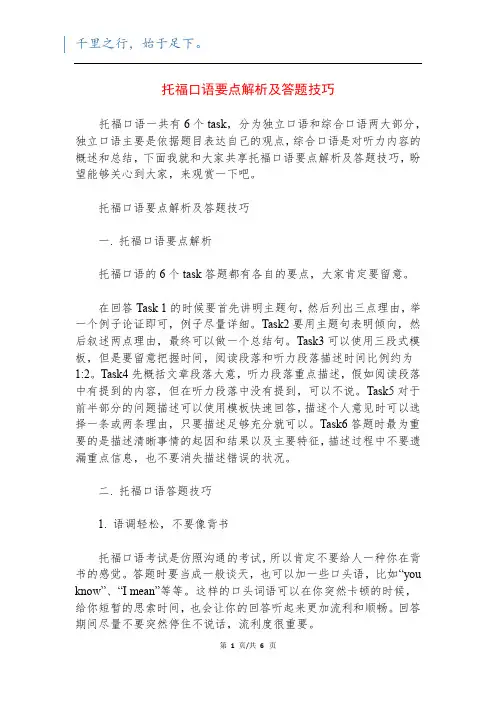
托福口语要点解析及答题技巧托福口语一共有6个task,分为独立口语和综合口语两大部分,独立口语主要是依据题目表达自己的观点,综合口语是对听力内容的概述和总结,下面我就和大家共享托福口语要点解析及答题技巧,盼望能够关心到大家,来观赏一下吧。
托福口语要点解析及答题技巧一. 托福口语要点解析托福口语的6个task答题都有各自的要点,大家肯定要留意。
在回答Task 1的时候要首先讲明主题句,然后列出三点理由,举一个例子论证即可,例子尽量详细。
Task2要用主题句表明倾向,然后叙述两点理由,最终可以做一个总结句。
Task3可以使用三段式模板,但是要留意把握时间,阅读段落和听力段落描述时间比例约为1:2。
Task4先概括文章段落大意,听力段落重点描述,假如阅读段落中有提到的内容,但在听力段落中没有提到,可以不说。
Task5对于前半部分的问题描述可以使用模板快速回答,描述个人意见时可以选择一条或两条理由,只要描述足够充分就可以。
Task6答题时最为重要的是描述清晰事情的起因和结果以及主要特征,描述过程中不要遗漏重点信息,也不要消失描述错误的状况。
二. 托福口语答题技巧1. 语调轻松,不要像背书托福口语考试是仿照沟通的考试,所以肯定不要给人一种你在背书的感觉。
答题时要当成一般谈天,也可以加一些口头语,比如“you know”、“I mean”等等。
这样的口头词语可以在你突然卡顿的时候,给你短暂的思索时间,也会让你的回答听起来更加流利和顺畅。
回答期间尽量不要突然停住不说话,流利度很重要。
2. 内容丰满,自圆其说口语答题时,肯定要留意答案的丰满度,比如,举例论证的时候,肯定要将例子表达完整。
规律关系明确,假如分点回答,可以用“first,second,third”等词汇过渡,让自己的回答听起来条理清楚。
答题时分论据肯定要和自己的主题论据全都,能够自圆其说,切忌前后互不照应。
3. 平常多练习托福口语的平常需要多练习,假如平常没有打好基础,那么考试中的技巧再好也是没有用的。
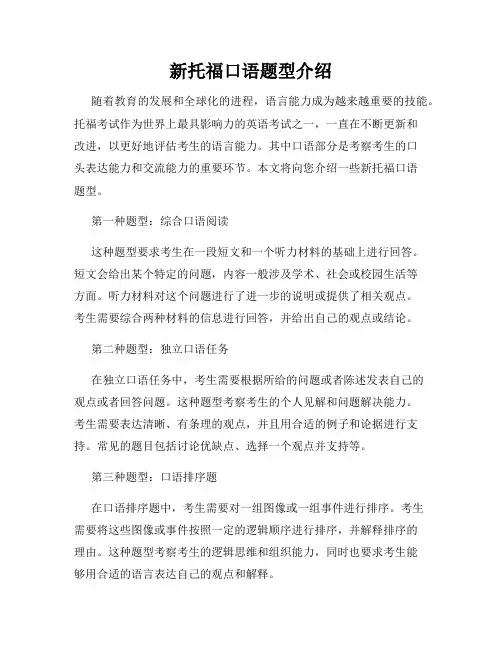
新托福口语题型介绍随着教育的发展和全球化的进程,语言能力成为越来越重要的技能。
托福考试作为世界上最具影响力的英语考试之一,一直在不断更新和改进,以更好地评估考生的语言能力。
其中口语部分是考察考生的口头表达能力和交流能力的重要环节。
本文将向您介绍一些新托福口语题型。
第一种题型:综合口语阅读这种题型要求考生在一段短文和一个听力材料的基础上进行回答。
短文会给出某个特定的问题,内容一般涉及学术、社会或校园生活等方面。
听力材料对这个问题进行了进一步的说明或提供了相关观点。
考生需要综合两种材料的信息进行回答,并给出自己的观点或结论。
第二种题型:独立口语任务在独立口语任务中,考生需要根据所给的问题或者陈述发表自己的观点或者回答问题。
这种题型考察考生的个人见解和问题解决能力。
考生需要表达清晰、有条理的观点,并且用合适的例子和论据进行支持。
常见的题目包括讨论优缺点、选择一个观点并支持等。
第三种题型:口语排序题在口语排序题中,考生需要对一组图像或一组事件进行排序。
考生需要将这些图像或事件按照一定的逻辑顺序进行排序,并解释排序的理由。
这种题型考察考生的逻辑思维和组织能力,同时也要求考生能够用合适的语言表达自己的观点和解释。
第四种题型:口语综合任务这种题型结合了独立口语任务和综合口语阅读,要求考生在听到一段短文后,回答相关问题或者发表自己的观点。
这种题型考察考生对听力材料的理解和运用能力,同时也需要考生能够对材料进行分析和评价。
新托福口语题型注重考察考生的语言运用能力、逻辑思维和组织能力,要求考生具备良好的听力和口语表达能力。
为了准确回答问题,考生需要在短时间内理解问题并给出合理的回答。
因此,平时要注重听力训练,提高自己的语言理解能力,并多做口语练习,熟悉各种题型的要求和答题技巧。
通过不断的练习和积累,相信大家一定能够在新托福口语考试中取得好成绩。
总结:新托福口语题型包括综合口语阅读、独立口语任务、口语排序题和口语综合任务。
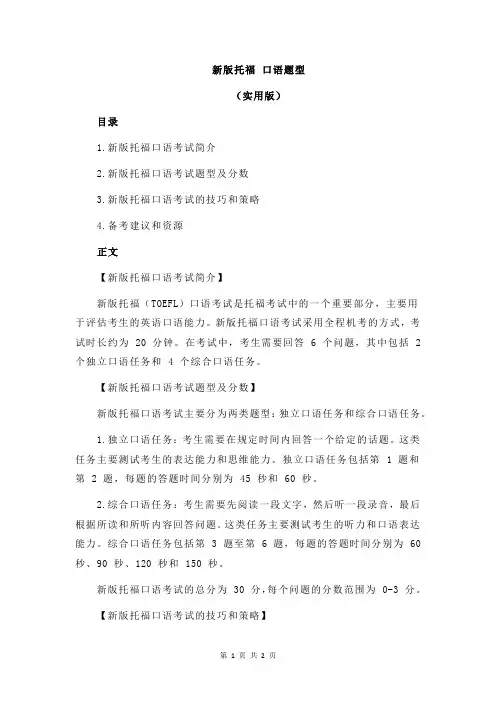
新版托福口语题型(实用版)目录1.新版托福口语考试简介2.新版托福口语考试题型及分数3.新版托福口语考试的技巧和策略4.备考建议和资源正文【新版托福口语考试简介】新版托福(TOEFL)口语考试是托福考试中的一个重要部分,主要用于评估考生的英语口语能力。
新版托福口语考试采用全程机考的方式,考试时长约为 20 分钟。
在考试中,考生需要回答 6 个问题,其中包括 2 个独立口语任务和 4 个综合口语任务。
【新版托福口语考试题型及分数】新版托福口语考试主要分为两类题型:独立口语任务和综合口语任务。
1.独立口语任务:考生需要在规定时间内回答一个给定的话题。
这类任务主要测试考生的表达能力和思维能力。
独立口语任务包括第 1 题和第 2 题,每题的答题时间分别为 45 秒和 60 秒。
2.综合口语任务:考生需要先阅读一段文字,然后听一段录音,最后根据所读和所听内容回答问题。
这类任务主要测试考生的听力和口语表达能力。
综合口语任务包括第 3 题至第 6 题,每题的答题时间分别为 60 秒、90 秒、120 秒和 150 秒。
新版托福口语考试的总分为 30 分,每个问题的分数范围为 0-3 分。
【新版托福口语考试的技巧和策略】要想在新版托福口语考试中取得好成绩,考生需要掌握一些基本的技巧和策略:1.提高口语表达能力:考生需要通过大量的练习提高自己的口语表达能力。
可以参加口语培训班,或与英语母语者进行口语交流。
2.增强思维能力:考生需要学会在短时间内快速思考和组织语言。
可以通过练习即兴演讲和回答问题来提高思维能力。
3.熟悉考试题型:考生需要熟悉新版托福口语考试的题型,了解每个问题的答题要求和技巧。
可以通过模拟考试和观看考试教程来提高对考试题型的熟悉度。
4.积累词汇和语法:考生需要积累大量的词汇和语法知识,以便在考试中能够准确地表达自己的观点。
【备考建议和资源】1.参加托福培训班:参加专业的托福培训班可以帮助考生系统地学习新版托福口语考试的知识和技巧。
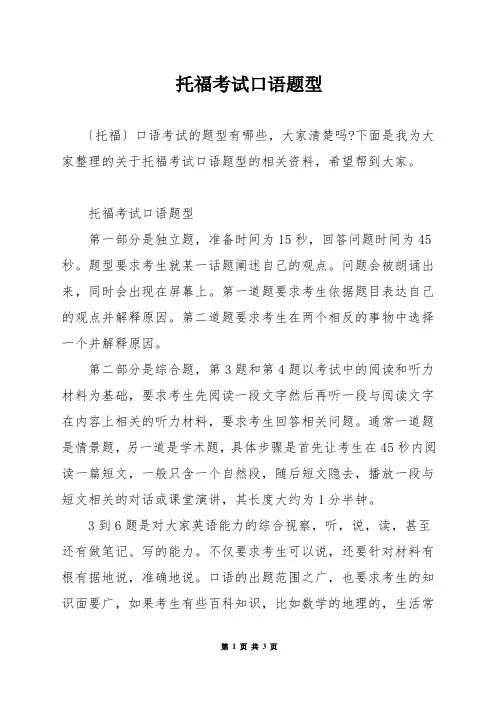
托福考试口语题型〔托福〕口语考试的题型有哪些,大家清楚吗?下面是我为大家整理的关于托福考试口语题型的相关资料,希望帮到大家。
托福考试口语题型第一部分是独立题,准备时间为15秒,回答问题时间为45秒。
题型要求考生就某一话题阐述自己的观点。
问题会被朗诵出来,同时会出现在屏幕上。
第一道题要求考生依据题目表达自己的观点并解释原因。
第二道题要求考生在两个相反的事物中选择一个并解释原因。
第二部分是综合题,第3题和第4题以考试中的阅读和听力材料为基础,要求考生先阅读一段文字然后再听一段与阅读文字在内容上相关的听力材料,要求考生回答相关问题。
通常一道题是情景题,另一道是学术题,具体步骤是首先让考生在45秒内阅读一篇短文,一般只含一个自然段,随后短文隐去,播放一段与短文相关的对话或课堂演讲,其长度大约为1分半钟。
3到6题是对大家英语能力的综合视察,听,说,读,甚至还有做笔记、写的能力。
不仅要求考生可以说,还要针对材料有根有据地说,准确地说。
口语的出题范围之广,也要求考生的知识面要广,如果考生有些百科知识,比如数学的地理的,生活常识相关的,那么当这样的题目出现时,就能更从容地面对和解决。
托福口语如何备考1.了解了托福口语考试到底怎么出题之后,接下来,我们就应该选择一些材料学习!但是自从托福考试进入中国以来,市场中的各种托福口语备考资料可谓是琳琅满目,并不是每一份资料都是可以有效帮助大家备考,提升托福口语成绩的。
建议考生选择血统纯正的由官方出版的一些资料,用以帮助自己了解托福口语出题规律,掌握托福口语答题技巧。
2.词汇是备考托福口语的基础。
如果想在托福口语考试中取得高分,考生首先应该攻克的就是词汇关。
前程百利我建议,考生在记忆词汇的时候,应该运用一些技巧和方法比如词根记忆法,词缀记忆法,谐音记忆法,和情景连想法来重点记忆在托福独立口语考试中常常出现的话题比如人物类,住宿类等话题中常常使用的词汇,而且考生在记忆词汇的时候,一定要注意不要进入记忆词汇的误区,要学会区分那些在考试中容易混淆的词汇。
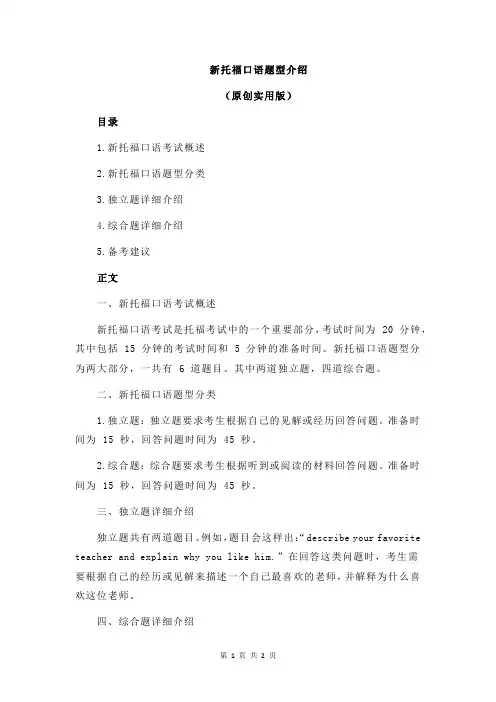
新托福口语题型介绍(原创实用版)目录1.新托福口语考试概述2.新托福口语题型分类3.独立题详细介绍4.综合题详细介绍5.备考建议正文一、新托福口语考试概述新托福口语考试是托福考试中的一个重要部分,考试时间为 20 分钟,其中包括 15 分钟的考试时间和 5 分钟的准备时间。
新托福口语题型分为两大部分,一共有 6 道题目。
其中两道独立题,四道综合题。
二、新托福口语题型分类1.独立题:独立题要求考生根据自己的见解或经历回答问题。
准备时间为 15 秒,回答问题时间为 45 秒。
2.综合题:综合题要求考生根据听到或阅读的材料回答问题。
准备时间为 15 秒,回答问题时间为 45 秒。
三、独立题详细介绍独立题共有两道题目。
例如,题目会这样出:“describe your favorite teacher and explain why you like him.”在回答这类问题时,考生需要根据自己的经历或见解来描述一个自己最喜欢的老师,并解释为什么喜欢这位老师。
四、综合题详细介绍综合题共有四道题目。
这类题目要求考生根据听到或阅读的材料回答问题。
在回答这类问题时,考生需要综合运用自己的听力和阅读能力,理解材料的主旨,并在规定时间内回答问题。
五、备考建议1.提高口语能力:考生在备考期间应该多进行口语练习,提高自己的口语表达能力。
2.积累素材:考生在备考期间应该多积累一些口语素材,以便在考试中能够迅速找到思路。
3.模拟练习:考生在备考期间应该进行模拟练习,以便熟悉考试的流程和时间安排。
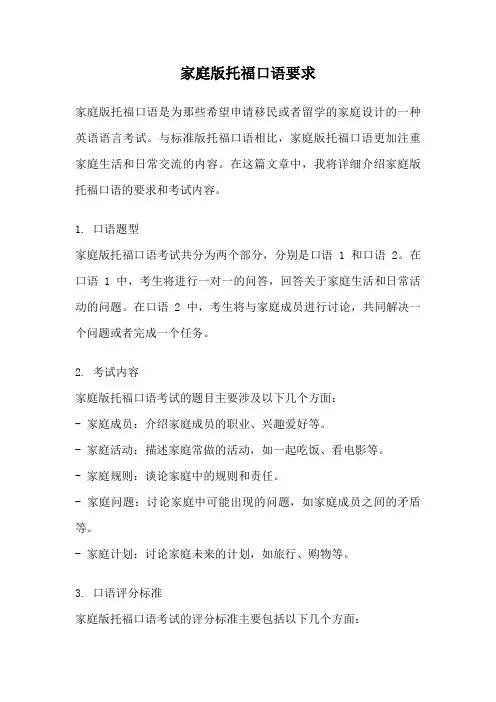
家庭版托福口语要求家庭版托福口语是为那些希望申请移民或者留学的家庭设计的一种英语语言考试。
与标准版托福口语相比,家庭版托福口语更加注重家庭生活和日常交流的内容。
在这篇文章中,我将详细介绍家庭版托福口语的要求和考试内容。
1. 口语题型家庭版托福口语考试共分为两个部分,分别是口语1和口语2。
在口语1中,考生将进行一对一的问答,回答关于家庭生活和日常活动的问题。
在口语2中,考生将与家庭成员进行讨论,共同解决一个问题或者完成一个任务。
2. 考试内容家庭版托福口语考试的题目主要涉及以下几个方面:- 家庭成员:介绍家庭成员的职业、兴趣爱好等。
- 家庭活动:描述家庭常做的活动,如一起吃饭、看电影等。
- 家庭规则:谈论家庭中的规则和责任。
- 家庭问题:讨论家庭中可能出现的问题,如家庭成员之间的矛盾等。
- 家庭计划:讨论家庭未来的计划,如旅行、购物等。
3. 口语评分标准家庭版托福口语考试的评分标准主要包括以下几个方面:- 流利度:口语表达是否流利,是否有停顿和重复。
- 语法准确性:句子结构是否正确,是否使用恰当的语法。
- 词汇使用:是否使用丰富的词汇,是否能准确表达意思。
- 语音语调:发音是否准确,语调是否自然。
- 逻辑性:回答是否连贯,是否能清晰地表达观点。
4. 备考建议为了备考家庭版托福口语考试,考生可以采取以下几个策略:- 多与家人进行口语练习,模拟考试环境。
- 多听英语家庭生活的相关音频,提高听力理解能力。
- 多读英语家庭生活的相关文章,扩大词汇量。
- 注重口语表达的流利度和准确性,可以通过模仿和跟读来提高口语水平。
- 注意语音语调的准确性,可以通过听力练习和录音自我评估来改善发音。
总结:通过本文,我们对家庭版托福口语的要求有了更加深入的了解。
考生在备考过程中,可以通过多方面的准备来提高口语水平,从而在考试中取得好成绩。
希望各位考生能够在家庭版托福口语考试中取得好的成绩,实现自己的移民或留学梦想。
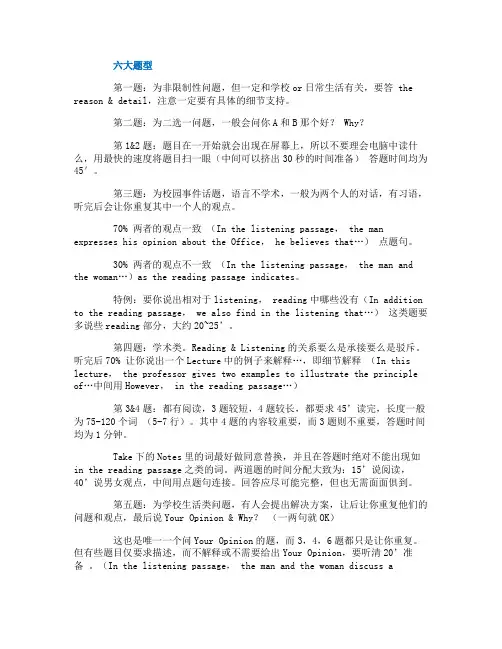
六大题型第一题:为非限制性问题,但一定和学校or日常生活有关,要答 the reason & detail,注意一定要有具体的细节支持。
第二题:为二选一问题,一般会问你A和B那个好? Why?第1&2题:题目在一开始就会出现在屏幕上,所以不要理会电脑中读什么,用最快的速度将题目扫一眼(中间可以挤出30秒的时间准备)答题时间均为45'。
第三题:为校园事件话题,语言不学术,一般为两个人的对话,有习语,听完后会让你重复其中一个人的观点。
70% 两者的观点一致(In the listening passage, the man expresses his opinion about the Office,he believes that…)点题句。
30% 两者的观点不一致(In the listening passage, the man and the woman…)as the reading passage indicates。
特例:要你说出相对于listening, reading中哪些没有(In addition to the reading passage,we also find in the listening that…)这类题要多说些reading部分,大约20~25’。
第四题:学术类。
Reading & Listening的关系要么是承接要么是驳斥。
听完后70% 让你说出一个Lecture中的例子来解释…,即细节解释(In this lecture, the professor gives two examples to illustrate the principle of…中间用However, in the reading passage…)第3&4题:都有阅读,3题较短,4题较长,都要求45’读完,长度一般为75-120个词(5-7行)。
其中4题的内容较重要,而3题则不重要,答题时间均为1分钟。
三立教育专家介绍托福口语常见题型托福口语题目总共有6个,持续时间大概是在20分钟。
第一题和第二题都是独立题,第三、四、五以及六道题全部是综合题。
今天三立教育老师就给大家介绍下托福口语常见题型。
托福口语共有6题,持续时间约20分钟。
第一题和第二题都是独立题,准备时间大概是15秒,回答问题时间大概是45秒。
三立教育老师表示题型需要大家根据某一话题阐述自己的观点。
问题通常是会被朗读出来,并且还会在屏幕上出现。
第一道题需要大家按照题目表达自己的观点并解释原因。
第二道题还要大家在两个相反的事物中选择一个并解释原因。
第三、四、五,六道题均为综合题。
第三题和第四题主要集合了读,听,说的形式。
阅读时间大概是45秒,听力时间大概是60秒到120秒,准备时间大概是30秒,回答时间大概是在60秒。
相当于是首先去阅读一篇文章,听一篇文章,而后再去回答问题。
阅读材料通常是一个自然段,75到100个单词,听力材料都是2个学生的对话,是对阅读材料中提出的问题的评论。
第四题就是学术题,学生学习方面的,阅读材料为75-100个单词的长度学术性材料,托福听力材料是老师的课堂讲解。
考生可以在听录音的过程中做笔记来帮助答题。
第五题和第六题集合了听、说的形式。
相比第三、四题少了一份阅读材料。
听力时间为60秒-120秒,准备时间为20秒,回答时间为60秒。
第五道题是听力材料题。
它是一道情景题,是学生之间关于学习生活中涉及的任意话题的对话。
第六道题是学术题,内容可如历史课老师在讲课等,考生可以在听录音的过程中做笔记来帮助答题。
以上是三立教育老师介绍有关托福口语常见题型的详细内容,希望大家能从中受益,不断改进自己的备考方法提升备考效率,从而获得满意的成绩。
托福口语备考资料及题型详解托福口语备考的过程中,我们首先要了解的有两件事:第一,口语的题型都有哪些;其次,用什么资料备考。
下面我就和大家共享托福口语备考攻略,来观赏一下吧。
托福口语备考攻略丨口语备考资料及题型详解一.托福口语题目详解1.独立口语口语1、2题我放在一起说,由于他们的内容相差不大,基本上预备好的例子可以套用。
这里说一下两道题需要留意的东西:机经,这两道题看机经关心很大,由于通过机经大体就能知道ETS的出题方式和出题方向了。
这一点要感谢我的男伴侣,理科生的规律力量很强大啊。
他给我总结了一些万能例子,就是用回答一道题的例子能同时回答好几道题,并且不用转变其中的内容。
他总结了大约15个例子,我改完以后就照着那个背,然后在考试的时候果真可以用到。
就是这种类型的东西,总结了15个,所以在预备第一二题的时候也就没有费多大力气。
最终,我建议大家最好早进场,但不要太早,保持在7-12名之间最好,这样既能保证你做听力的时候不被干扰,还能在休息的时候听一下口语1、2题,一举两得。
2.综合口语这些题目基本上都结合了听力和阅读,在我看来就是对已考两部分的延长考察。
所以,我认为与其专心预备这两部分,不如努力预备阅读和听力。
大家不要误会,这里不是说要放弃预备这些部分,而是在预备阅读、听力的时候顺带预备一下口语3-6题。
认真想一下,实际上这写题目就是总结,总结阅读,总结听力。
我在预备这些部分的时候,就是结合阅读和听力练习的。
比如,在昨晚阅读以后,我就把阅读文章的每一段都抽出来,然后一段一段的概括,这些概括本就没有对错之别,你只要专心去练习就好了。
听力就用同样的方法,把文章听完以后,然后尝试概括整篇文章的内容。
有些筒子可能会说听力内容比较长,但是不要担忧,由于你在预备长文章的同时,你的练习时间也会延长的,所以练习的时间并没有缩短。
有童鞋会问,那不是还有的要加上自己的看法么?对了,这不就是你在第1、2题里面做的么,第1、2题预备出来的例子,也刚好用在这一点,当然,你要留意以下,最好不要用同样的例子。
1.托福独立口语TASK1题型细节分析1、新托福口语的task1以生活类话题为主,相对综合口语的答题要求并不是那么复杂。
这个task的题目并不涉及到阅读和听力短文,学生只需回答听到的问题即可。
学生会有15秒的准备时间和45秒的回答时间。
但是,这道考题并不是单纯的就一个话题进行论述,而是给出两种观点,考生就这两种观点发表自己的看法,并且通常需要给出自己的偏向。
在论述的过程中,考生能否给出具有说服力的理由是得分的关键。
其实这部分的考题非常类似于雅思大作文task2的考题的出题形式,并且在回答思路上也是非常相近的。
2、托福task1虽然属于生活类话题,但话题的覆盖面还是相当广的。
常见的有:媒体类、教育类、环境类、抽象类、工作类、休闲娱乐类、生活类、地点类等。
3、应对这样的考题有很多种方式和结构,在这里,我们推荐给大家一种较为简单的结构。
首先先给出一个让步,即先就自己不同意的意见进行论述,并阐明这种观点的可取之处。
2.托福口语如何高效备考托福口语的练习方法有很多,从背模板到做官方真题Official等等都是其中之一。
在众多的学习方法中,有些方法因为较高的时间投入和回报而受到考生推崇。
托福口语如何练习的问题一直困扰许多同学,大家缺乏有效的练习手段,而只能依赖大量做题来摸索出路。
1、口语材料巧准备针对托福口语的第一题,我们常把它称作独立任务。
应对这样的托福口语考试题目,我们可以准备一些常用的口语段子,大家可以根据不同话题准备几个属于自己的口语段子,这样在需要时就可得心应手。
针对托福口语的2-4题,大家可以做出问题的基本框架,利用这个框架来帮住自己理清思路。
把听到的内容填进空中,再在相关的地方填上自己的看法,这样答案便可轻松得到了。
2、模拟练习升水平在做了上述准备后,你便可以自己托福口语考试实战练习,看看自己的能力了。
你可以利用OG和模拟考软件来多加练习。
另外到了考前最后一个月,把预测的题目全部做一遍,测一下自己的口语水平。
托福口语有几部分题型托福口语主要分为两大部分:独立任务和综合任务。
1-2题为独立口语,3-4题为综合口语,下面就和大家分享托福口语有几部分题型,希望能够帮助到大家,来欣赏一下吧。
托福口语有几部分题型第一部分:Independent tasks(独立口语)--Task1Task2(针对常见话题表达自己的想法、观点、经验)Task1:例如:1.此题目没有正确答案,你完全可以基于你自己的经历,想法来回答。
2.时间最好要用完,或者至少说够40s。
3.一定要给出具体的例子和细节。
Task2:例如:1.先表明你的观点,然后给出具体的原因解释。
2.可以选择中态度,但是一定要表达清楚。
如In some cases it’s better to study in groups, while in other cases studying alone is better.第二部分:Integrated tasks(综合口语)-- Task3-Task6(考察学生听力、阅读和口语表达的综合能力)Task3 校园生活类考查形式:Reading(45s) + Listening + Speaking(60s) Preparation time:30s阅读:先阅读一段短文:学校的通知或者学生对学校的提议,以及对应的两个原因。
听力:听两个学生的对话,其中一个学生会表示同意或者不同意阅读的内容,并且给出相应的两个原因。
口语:你的任务是结合阅读内容,概括学生的态度以及两个原因。
Task4:学术类考查形式:Reading(45s) + Listening + Speaking(60s) Preparation time:30s阅读:先阅读一段短文:对一种学术现象或者概念的概括。
听力:听教授对阅读中的学术现象,进行详细的解释,通常会通过具体的例子来说明。
口语:你的任务是结合阅读内容和教授的例子,概括并解释该学术现象。
Task5 校园生活类考查形式:Listening + Speaking(60s) preparation time:20s 听力听两个人物的对话,对话中,其中一个人会遇到生活或学习上的困难,并且他们会讨论出两种可能的解决方案。
托福口语4题一、托福口语四道题题型介绍1. 新托福独立口语题型第1题和第2题为独立回答题,准备时间为15秒,回答问题时间为45秒。
问题会被朗读出来,同时会出现在屏幕上。
第一道题是情景题。
阅读材料为一个自然段,75-100个单词,阅读材料的时间是45秒;要求考生根据题目表达自己的观点并解释原因;第二道题要求考生在两个相反的事物中选择一个并解释原因。
2. 新托福综合口语综合口语第一类综合口语第3题和第4题为第一类综合口语题,以阅读和听力材料为基础,要求考生回答相关问题。
听力材料是两个学生的对话,是对阅读材料中提出的问题的评论,长度为60-80秒。
另一道是学术题,阅读材料为75-100个单词的长度学术性材料,阅读时间为45秒。
听力材料是老师的课堂讲解,长度为60-90秒考生可以在听录音的过程中做笔记来帮助答题。
答题的时候,考生有30秒的准备时间,60秒的回答问题时间。
综合口语第二类口语考试第5题和第6题为综合口语第二类,以听力材料为基础,要求考生回答相关问题。
听力材料一道题是情景题,是学生之间关于学习生活中涉及的任意话题的对话,长度为1分钟60-90秒;另一道是学术题,比如历史课老师在讲课,长度为90-120秒。
考生可以在听录音的过程中做笔记来帮助答题。
答题时,考生有20秒的准备时间,60秒的时间回答问题。
二、托福口语答题技巧1、托福口语task1答题技巧task1最常考的就是偏好题,通过智课老师的仔细研究,这类题型常出现的话题是人物话题、地点话题、事件话题或者是物品话题。
针对这类题型,同学们可以针对一个话题不断的神话,而且完全可以一个例子通用到各类话题中。
如果在文章的开头进行表述,最好是将主体分为三部分来阐述,开题无需技巧,简单读题即可,把you 都改成me,比起I think……开头可以省去相对多的思维时间。
内容一般找三个理由,为避免理由重复或累赘,建议就方便、经济、减压等常用理由进行练习,并结合不断问自己How 及Why 等问题来充实内容,完成example 的部分。
tpo56 口语(最新版)目录1.口语的重要性2.提高口语能力的方法3.TPO56 口语材料的特点和价值4.如何使用 TPO56 提高口语能力正文一、口语的重要性在当今社会,口语能力显得越来越重要。
无论是在日常生活中还是工作场合,良好的口语能力都能帮助我们更好地与他人沟通,增进彼此的了解。
尤其是在我国,随着国际交流的日益频繁,拥有一口流利的英语口语已经成为了很多人追求的目标。
二、提高口语能力的方法想要提高口语能力,可以从以下几个方面入手:1.大量阅读:阅读可以帮助我们积累词汇和语法,为口语表达打下基础。
2.模仿练习:模仿优秀的口语材料,如英语电影、电视剧、播客等,可以提高我们的发音和语调。
3.实际交流:多与他人进行口语交流,可以提高我们的反应速度和语言组织能力。
4.录音自评:通过录音自己的口语练习,可以发现自己的不足之处,并进行针对性的改进。
三、TPO56 口语材料的特点和价值TPO(Test Preparation Office)是托福考试官方发布的模拟题,其中包含了大量的口语练习材料。
TPO56 是其中的一份口语材料,具有以下特点和价值:1.真实性:TPO56 的口语题目均来源于真实场景,能让考生更好地了解托福考试的题型和难度。
2.系统性:TPO56 涵盖了托福口语的全部题型,可以帮助考生系统地学习和练习。
3.权威性:作为官方发布的材料,TPO56 的质量和准确性得到了保证。
四、如何使用 TPO56 提高口语能力使用 TPO56 提高口语能力,可以采取以下步骤:1.熟悉题型:首先,了解托福口语的题型和考试要求,为接下来的练习做好准备。
2.模仿练习:其次,模仿 TPO56 中的优秀答案,提高自己的口语表达能力。
3.实际应用:然后,通过与他人进行口语交流,将 TPO56 中学到的知识和技巧应用到实际中。
4.自我评价:最后,通过录音自评,找出自己的不足之处,并根据TPO56 的答案进行改进。
Useful tips: (suitable for all questions)☛Make it NATURAL, pauses, such as “well”, “um”, and “you know”, areadvisable, but don’t do it too much.☛CORRECT your mistakes as soon as you find out, for example, “ (I)really like standing in, I mean, ON the mountain,”(I know it’s a badexample. What I’m trying to clarify is that it is OK to make mistakes,but you gotta correct it once you made it.) so the examiner would notcount down your score.☛There is NO NEED to use freaking words, like “exonerate”, whichmeans absolve, and “flamboyant”, which means showy. But thosewords are good to use in your essay.☛“The FIRST way, the LAST way, the NEVER FAILING way to developself-confidence in speaking is--TO SPEAK.” --Dale CarnegieIndependent speaking (Question 1 & 2)In this section, you are asked to present your own opinion and provideexamples to support your ideas.Useful tips:☛Your answer should be as SPECIFIC as possible. You need to stick to apoint UNTIL you finish it, have done with it, and need never return toit again.☛The key to score high is to make each point WELL-DEVELOPED, andthat DOES NOT mean you need to make as much points as you can,two would be great.☛Truth and REASONABLE LIES are totally acceptable.☛DO NOT say “I have three(or whatever) reasons to support my idea”,or some thing like that after you state your opinion. There is noguarantee that you are able to finish your answer within 45 seconds.Instead, you can say “I have a couple of reasons to say.”Question 1 Free-choice Independent Task这道题完全照搬TSE的Recommending places题型,扩展到People, Activities(Events)和Objects。
准备15秒,说45秒。
虽然是第一题,但确不是最简单的。
理由:(a)回答第一题比较紧张,因为刚进入口语,还没有进入状态,所以很容易因为紧张,就闷了。
(b)第一题的问题几乎没有什么提示,这里所谓的提示,指答案的提示。
不像第2题,A or B是有提示的,回答A,B,甚至A+B都可以。
所以第一题还可能卡在理由上,例子上。
第一题的出题范围分为四个方面:1.地点类(place)ex: Describe your favorite placein the city and explain why you like thisplace.(2006/1/6) (2006/7/15)2.事情或活动类(event or activity)ex: Describe the most importantdecision you have made in your life.(2005/12/2)3.人物类(person)ex: Describe yourfavorite teacher and explain how this teacher influenced you.4.物体类(objects)ex: Describe thebest/worst invention in the 20th century and explain how it affects your life.1、要言之有物,不要空喊口号,客观表达!2、要扣题评述,表达主观意见(正面)。
3、要以面带点,不可纵向深入,因为:(1)铺开表达可以灵活搭配事先背诵的小点,不被具体题目限定。
(2)可以在句式结构上套用模板,沉着应对,并给人逻辑清晰的印象。
(3)可避免纵向层面语汇短缺所引起的错误表达。
(4)可避免不经意间走题。
Your answer can go like this:“Personally, I would have to say that, um, my favorite ... is ... . And thereare a couple of reasons to name. The most important thing is that, youknow, ... . What’s more, ... . So that’s why ... .”Question 2 Paired-choice Independent TaskQ2相对于Q1来说,好回答的多。
Q2的问题是:A or B, why?或者do or not do? 再或者A,B,C...which one prefer?这道题完全照搬TWE题型。
准备15秒,说45秒。
1、同样建议以面代点,不要纵向深入。
2、四种Reasoning:(1) Core Node Reasoning(2) "Devouring the Opposition" Reasoning(3) Counter-example Illustration Reasoning(4) Blocking (Declining to give opinion)所以对于回答Q2,充分利用题干的提示,迅速作出选择,其实一但做了选择,问题就又回到Q1的解答方法了。
下面看几个真题:(1) 电视对于现代社会有正面作用还是负面作用,选择其中之一并解释原因这是A or B(2)Do you think the high school should teach music andart as other basic science?这是do or not do(3)媒体(tv,internet….)和人(朋友,家长,同学)从哪方面你能学到更多的东西?这是A,B,C...which one prefer?回答技巧:(1) 迅速选择,不要犹豫,这个题目回答没有对错,能自圆其说就好。
(2)一旦选择,回答得思路可以回到Q1,句型,结构可以用一样的。
(3) 当缺少理由时,可以用正面,反面回答得方法,可以充实理由库ex:Do you think the high school should teach music andart as other basic science?态度:应该理由1:有助于培养学生的想象力理由2:(如果想出来正面理由)如果不上music and art的坏处:学生缺少想象力这样一来,把一个理由分两个用(4) 建议用作文的题库来练习, 选上述3种问法的题目来练,既能复习作文,也能练习口语。
把185里面的题目挑出来反复练习就可以了。
(5) Q1和Q2不是没有关系的,Q1准备的内容很多时候能用在Q2的题目上,所以多多练习,这样可以缩小准备的内容,争取把这些内容弄得滚瓜烂熟。
TASK 2万金油式的回答It depends on different stages.It depends on one’s abilities.It depends on one’s personality.It depends on the nature of the subject.This is quite a complex question.It depends on…….If you……. For example……, you’d better……in order to…….On the other hand, if……, for example……, you’d better…… in order to…….As far as I’m concerned,……(观点). Firstly, …….Also,…….What’ more,…….So I’d rather choose…….Ex: Some students study for classes individually. Others study in groups. Which method of studying do you think is better for students and why.Your answer can go like this:“Well, in my opinion, I would definitely agree with the point that, um, ... .The first reason that I wanna say is that ... . More importantly, ... . So,uh, that’s why I choose ... for the two reasons listed above.”“Well, in my opinion, I would definitely agree with the point that, um, ... .The first reason that I wanna say is that ... . More importantly, ... . So,uh, that’s why I choose ... for the two reasons listed above.”第一、二题Self-Assessment Checklist:1. I read the question carefully.2. I used careful planning to outline my response.3. I began with a topic statement.4. I used strong supporting ideas.5. I used transitions to connect the supporting ideas.Integrated speaking (Question 3, 4, 5 & 6)In this part, you are asked to paraphrase the man/woman’s attitudefirst, and then list the reasons s/he gives. You are NOT asked to presentyour opinion towards this problem.Question 3 Dialogue-based R-L-S Integrated Task这道题通常是关于university policies, rules or procedures; university plans; campus facilities or quality of life on campus的一些新的变化,对话中的一个人支持或者反对这个变化,并且给出理由,题目的要求就是复述其中一人的观点并且列举出这个人的理由(注意:不能说自己的观点!)。